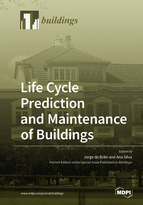Life Cycle Prediction and Maintenance of Buildings
A special issue of Buildings (ISSN 2075-5309). This special issue belongs to the section "Building Structures".
Deadline for manuscript submissions: closed (31 May 2020) | Viewed by 70825
Special Issue Editors
Interests: CIB—International Council for Research and Innovation in Building and Construction; durability of building elements, maintenance of buildings; rehabilitation of buildings; building life cycle assessment
Special Issues, Collections and Topics in MDPI journals
Interests: service life prediction, durability and life cycle of buildings and their components; maintenance modelling; statistical models
Special Issues, Collections and Topics in MDPI journals
Special Issue Information
Dear Colleagues,
The sustainability of the built environment can only be achieved through the maintenance planning of built facilities, during their lifecycle, considering social, economic, functional, technical and ecological aspects. Stakeholders should be conscious of the existing tools and knowledge for the optimization of maintenance and rehabilitation actions, considering the degradation mechanisms and the risk of failure over time. Knowledge concerning the service life prediction of building elements is crucial to the definition, in a rational and technically informed way, of a set of maintenance strategies over the building’s life cycle. Service life prediction methodologies provide a better understanding of the degradation phenomenon of the elements under analysis, enabling the relation of the characteristics of these elements, their exposure, use and maintenance conditions with their performance over time.
This Special Issue intends to provide an overview of the existing knowledge related with various aspects of Life Cycle Prediction and Maintenance of Buildings.
Original research, theoretical and experimental, case studies, and comprehensive review papers are invited for possible publication in this Special Issue. Relevant topics to this special issue include, but are not limited to the following subjects:
- Methodologies for service life prediction of buildings and components
- Maintainability of buildings and components
- Serviceability of buildings’ elements
- Maintenance and repair actions of buildings and components
- Definition and optimization of maintenance policies
- Financial analysis of various maintenance plans
- Whole Life Cycle Costing
- Life Cycle Assessment
Prof. Jorge de Brito
Dr. Ana Silva
Guest Editors
Manuscript Submission Information
Manuscripts should be submitted online at www.mdpi.com by registering and logging in to this website. Once you are registered, click here to go to the submission form. Manuscripts can be submitted until the deadline. All submissions that pass pre-check are peer-reviewed. Accepted papers will be published continuously in the journal (as soon as accepted) and will be listed together on the special issue website. Research articles, review articles as well as short communications are invited. For planned papers, a title and short abstract (about 100 words) can be sent to the Editorial Office for announcement on this website.
Submitted manuscripts should not have been published previously, nor be under consideration for publication elsewhere (except conference proceedings papers). All manuscripts are thoroughly refereed through a single-blind peer-review process. A guide for authors and other relevant information for submission of manuscripts is available on the Instructions for Authors page. Buildings is an international peer-reviewed open access monthly journal published by MDPI.
Please visit the Instructions for Authors page before submitting a manuscript. The Article Processing Charge (APC) for publication in this open access journal is 2600 CHF (Swiss Francs). Submitted papers should be well formatted and use good English. Authors may use MDPI's English editing service prior to publication or during author revisions.
Keywords
- Methodologies for service life prediction of buildings and components
- Maintainability of buildings and components
- Serviceability of buildings’ elements
- Maintenance and repair actions of buildings and component
- Definition and optimization of maintenance policies
- Financial analysis of various maintenance plans
- Whole Life Cycle Costing
- Life Cycle Assessment







